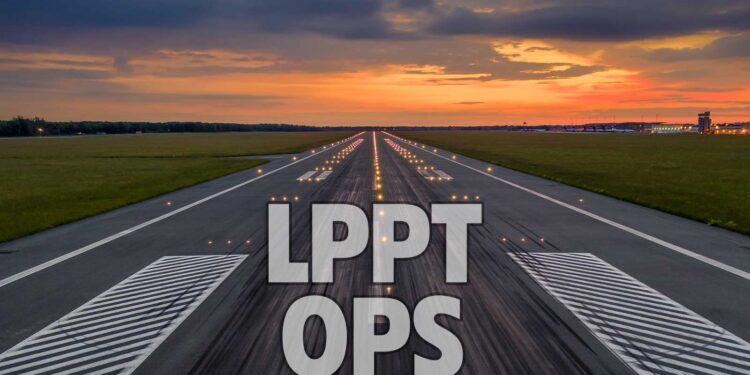Operating to LPPT – Part 1: Airports, Parking & Permits

This business aviation blog post is part of a series on operating to Lisbon.
Lisbon (LPPT) airport is conveniently located just five miles from the city center. LPPT is a busy location, with limitations on general aviation (GA) parking, so it’s best to plan on 10 days prior notice in order to obtain airport slots and parking. Operating options at this location diminish the closer you are to day of operation.
The following is an overview of what you need to know:
1. LPPT
LPPT is a 24–hour joint civilian/military airport of entry (AOE) located just outside the city center. The airport has a long 12,467 ft. runway with customs, immigration, and quarantine (CIQ) clearance, full services and fuel uplifts (Jet A only) available 24 hours. Note that there’s no fixed–base operator (FBO) or general aviation terminal (GAT) at this location so all CIQ clearances are done via the main terminal.
2. Parking restrictions
GA parking at LPPT is usually limited to three hours unless you’ve obtained prior approval for longer stays. Ad–hoc parking is restricted to a maximum of three hours between 0800–2200 UTC the summer and 0900–2300 UTC during the winter. However, with prior approval from Lisbon Airport Management it’s usually possible to stay for one or two nights, but depends on availability. For longer stays we recommend looking into hangar availability.
3. Alternate airports
If parking is denied for your particular operation to LPPT, parking alternatives include Faro (LPFR) and Porto (LPPR), both about 30 min flight time away, and Cascais (LPCS) which is only about five minutes flight time from LPPT. LPFR and LPPR are AOEs with operating hours of 0600–2359 local (no overtime possible), while LPCS is an AOE only upon request and operates 0800–sunset during winter and 0700–sunset during summer.
4. Landing permits
Private non–revenue operations do not require landing permits for travel to AOEs in Portugal, but do require them for domestic airfields. Charter (non–scheduled commercial) operators always require landing permits, with the exception of tech stops where no passengers or crew embark or disembark. Lead time is two business days for private non–revenue landing permits and four business days for charter permits and they’re valid for the Zulu day. Permit revisions are needed if you change origin, destination or schedule (outside of the Zulu day). For operations to the military side of LPPT, charter permits must be requested two weeks in advance while private non–revenue air ambulance permit requests should be submitted two days prior.
5. Permit documentation
The Civil Aviation Authority (CAA) processes permit requests and requires the airworthiness and registration certificates, worldwide insurance (meeting EU requirements) and noise certificates for private non–revenue operations to non–AOEs. Documentation for charter operations to Portugal is more rigorous and below are some of those requirements:
- 8.33 KHZ VHF radio spacing
- FM immunity – VHF COM/NAV
- Reduced vertical Separation Minimum (RVSM) certification
- Emergency locator transmitter (ELT)
- reinforced cockpit door
6. CAA hours
Portugal CAA operates Monday–Friday 0930–1230 and 1400–1700 local and is closed on the weekends and holidays. Short notice permit requests may be possible at CAA’s discretion. Note that permit requests for the military side of LPPT are only processed by the Portuguese Air Force.
7. Private vs. charter considerations
Under Portugal’s definition of charter flights most GA operations fall under CAA’s “own use flight” category and do not require charter permits. Own use is defined as an individual, corporation or institution that “charters” the entire capacity of the aircraft for the carriage of:
- Himself and/or the company’s staff and/or goods, or
- Persons associated with the charterer, provided the flights are:
- Of occasional character
- part of capacity is resold
- The charter price is not shared by the passengers
- No commercial arrangements are made for the total or partial, direct, or indirect, payment of the flight cost by persons other than the charterer or the owner of the aircraft
8. Documentation requirements upon landing
LPPT airport authority wants to see the following documents on arrival:
- Maximum takeoff weight (MTOW)
- registration and airworthiness certificates
- worldwide insurance certificate
This requirement applies only to aircraft operating to LPPT for the first time or aircraft is not listed in the airport authority database.
Passengers and crews must present valid passports on arrival as well as Schengen visas, depending upon nationality. Note that if visas are required they must be obtained prior to landing as they cannot be obtained upon arrival.
Conclusion
LPPT is a very busy airport with limited parking options. For operators intending to stay more than one or two nights at LPPT it’s important to work with your 3rd–party provider, as early in the trip planning process as possible, to confirm extended stay options. Hangar parking can also be considered.
Later, we’ll discuss slots, fuel, security, and operating trips for your travel to LPPT.
Questions?
If you have any questions about this article or would like assistance planning your next trip to Portugal, contact me at josephfleming@univ-wea.com.



